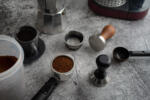When it comes to coffee, knowing where your beans come from can make all the difference in the flavor. Different regions in the world have unique soil, temperatures, and climates that all contribute to the flavor of coffee beans.
That is why it is important to understand the flavor profiles of each country so that you can make an informed decision when looking for a new coffee bean. In this blog post, we will explore the distinct characteristics and flavors of coffee from different countries around the world.

So, let’s get started!
Differences Between Latin American, African and Asian Coffees
Regarding flavor profiles, African, Latin American, and Asian coffees differ.
- African coffee beans tend to have citrus, floral, and fruitiness notes.
- Asian coffees have an earthy and darker profile than their Latin American counterparts.
- Central American and South American coffees are known for their spicy and complex flavor profile with fruit notes. At the same time, Mexican beans are often used in blends because of their excellent blend characteristics and chocolatey flavors. Latin American coffees tend to have a good body, acidity, and a hint of fruitiness.
All in all, each coffee-growing country has its unique flavor profiles that can make your coffee-drinking experience even more enjoyable.
AFRICA AND THE MIDDLE EAST
Coffee lovers around the world are always on the lookout for the perfect cup of coffee. With the wide variety of coffee beans on the market, it can be difficult to know what flavor profile to expect from each one. Fortunately, the flavor profile of each coffee bean can be largely determined by its country of origin.
African coffee beans are known for their vivid floral, fruity, and berry-tasting notes, bright acidity, and winey flavor. Ethiopia is the only country where coffee is wild-grown, making its flavor profile particularly diverse. Burundian, Rwandan, and Tanzanian coffees tend to have fruity, floral, and chocolatey flavor notes, with a silky-smooth mouthfeel and bright acidity.
Ethiopian-washed coffees evoke a cup of tea due to their delicate, floral flavor profile (think bergamot oil in Earl Grey). Look for the higher acidity and bright flavor notes if you buy African coffee! Generally, African coffees can taste fruity, floral, and sweet.
- Burundi: Coffee beans with a full body and acidity range from good to outstanding.
- Cameroon: Arabica coffee beans that are sweet and mellow, with good to exceptional quality.
- Ethiopia: Djimmah beans are full-bodied, with a spicy, earthy flavor and a strong aftertaste. Harrar beans are strong and winy.
- Kenya: Smooth, full-bodied, aromatic, and slightly acidic. Look for Kenyan coffee beans with the highest “AA” grade and those from the Chagga tribe.
- Rwanda: Rich, tangy beans of exceptional grade.
- Tanzania: Coffee beans have a complex, mellow flavor and good body and acidity. Look for those from Mount Kilimanjaro and Mount Bukoba.
- Yemen: Excellent Arabica coffee with a characteristic chocolatey flavor, frequently referred to as “Mocha” coffee beans after the now-closed Middle Eastern port of origin.
THE AMERICAS
Regarding flavor profiles of America’s coffee beans, they are relatively similar across the region. Generally, they are mild and light with notes of chocolate, nutty richness, and sometimes a hint of citrus acidity.
Colombian coffee is known for being especially flavorful, with notes of chocolate, nutty richness, and a hint of fruitiness. Mexico is also popular for its excellent blend characteristics and chocolatey, nutty flavor. Nicaragua produces beans with a unique flavor profile of nutty, apple, and pear notes.
Whether you’re looking for a light, mild cup of coffee or one with bold flavors, Latin American coffees are sure to have something that suits your taste.
- Brazil: Brazilian coffee generally has a solid but unexceptional flavor that makes it an excellent backbone for mixes. Brazilian Bourbon Santos coffee, on the other hand, stands out for its delicate, smooth, mild flavor.
- Colombia: Supremo and Excelso are the two highest grades of Colombian coffee beans. Medellin coffee from Colombia is robust, full-bodied, and somewhat acidic. Colombian coffee that has been aged is exceptionally sweet, syrupy, and creamy, with minimal acidity.
- Costa Rica: Costa Rican coffee beans are robust, full-bodied, flavorful, and sharply acidic.
- The Dominican Republic: Rich taste and moderate acidity distinguish this coffee. Look for those from Santo Domingo and Barahona.
- El Salvador: Look for coffee beans with moderate flavor, a nice body, and medium acidity.
- Guatemala: The finest beans come from the high mountains of Amatitlan, Antigua, and Coban and have a substantial body, strong acidity, and a hint of smoke or spice.
- Haiti: The flavor of Haitian coffee beans is rich and somewhat sweet, with a hefty body and moderate acidity.
- Hawaii: Kona coffee beans are famous for their great body, rich scent, and flavor, with notes of sweetness and spice.
- Jamaica: Jamaican Blue Mountain coffee is famous for being full-bodied, moderately acidic, and mellow.
- Mexico: Look for high-quality Mexican coffee beans with a fragrant scent, a substantial body, a rich taste, and a hint of acidity.
- Nicaragua: High-quality coffee will be mild and lightly acidic.
- Panama: The greatest Panamanian coffee has a moderate taste, a big body, and a lively acidity.
- Peru: Flavorful, with a tinge of acidity.
- Venezuela: Look for coffee from Cucutas and Tachiras that is rich and somewhat acidic, as well as coffee from Merida that has outstanding flavor and a light body.
ASIA AND INDONESIA
In Asia, coffee beans are mostly Arabica or Robusta. Depending on the process used, different flavor profiles can arise. Southeast Asian coffees are described as silky, rich, earthy, spicy, savory, and wild. In the Middle East, Arabica beans create a more muted flavor profile with moderate-high acidity and a clean mouthfeel. Moving further east, let’s explore the flavor profiles of coffee from different countries in Asia.
- Celebes. Celebes Kalosi coffee beans from this Indonesian island are nearly syrupy, full-bodied, and highly acidic.
- China: Yunnan coffee beans are full-bodied, deeply flavored, and somewhat sweet and acidic.
- India. Look for Mysore coffee beans that are full-bodied and somewhat acidic, as well as Malabar coffee that is rich and subtle.
- Java: The best Arabica beans from this coffee-obsessed island are full-bodied, peppery, and gently acidic.
- Papua New Guinea: New Guinea coffee beans feature a delicious flavor with a light body and scent.
- Sumatra: Sumatra’s best Arabica coffee beans are full-bodied, creamy, and mellow, with low acidity. Look for Sumatra Mandheling coffee, which is exceptionally sweet.
- Timor: Coffee beans have a strong taste and fragrance.
How to Identify Your Favorite Coffee Bean Profile
To identify your favorite coffee bean profile, it is important first to understand the different factors that influence its flavor.
Single-source coffees are a great starting point, as they originate from a specific region or country. This allows you to research their unique characteristics and determine if it’s a good fit for your palate.
Additionally, it’s important to compare your coffee to those of competitors. This will help you understand how your coffee stands out and what makes it unique.
When it comes to roasting, it’s essential to understand how temperature and timing affect the flavor and aroma of the coffee. Generally, lighter roasts are more acidic and bright, while dark roasts are more intense and smoky. It’s important to keep an eye on the beans during the roasting process, as they will change in both color and texture.
Finally, there are other factors that contribute to the quality of the coffee, such as the farm, the type of beans, the processing methods, and the storage techniques. By understanding each of these components and how they all work together, you can identify your favorite profile and make sure you enjoy a cup of delicious, high-quality coffee.
Conclusion
In summary, coffee beans have unique flavor profiles depending on the country of origin.
Latin American countries such as Peru, Colombia, and Brazil tend to have herbal and sweet fruity aromas, while African countries like Kenya and Ethiopia have more berry and citrus notes.
Asian coffees from Indonesia and Malaysia are characterized by their earthy, herbal notes. Ultimately, the flavor profile of each coffee bean depends on the terroir and cultivation methods used by the farmers. Whether you prefer a robust, earthy flavor or a light, fruity one, there is a coffee bean for everyone.

Editorial Staff
The editorial staff at Crazy Coffee Crave is a team of coffee enthusiasts & Baristas who enjoy the one thing we all think about as soon as we get up in the morning. Trusted by thousands of readers worldwide.






